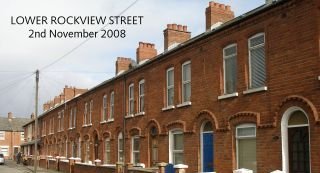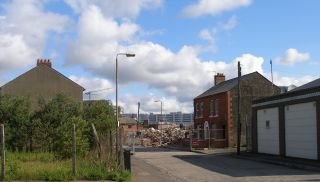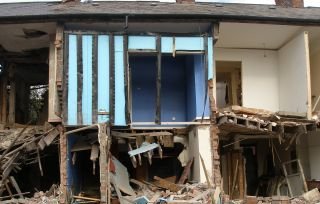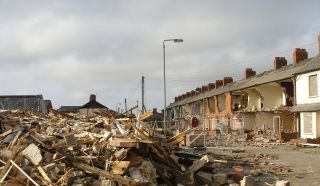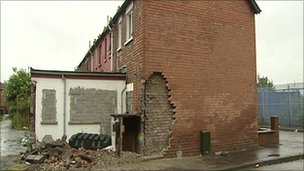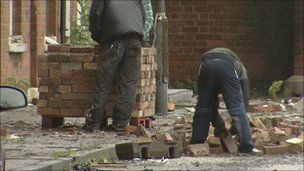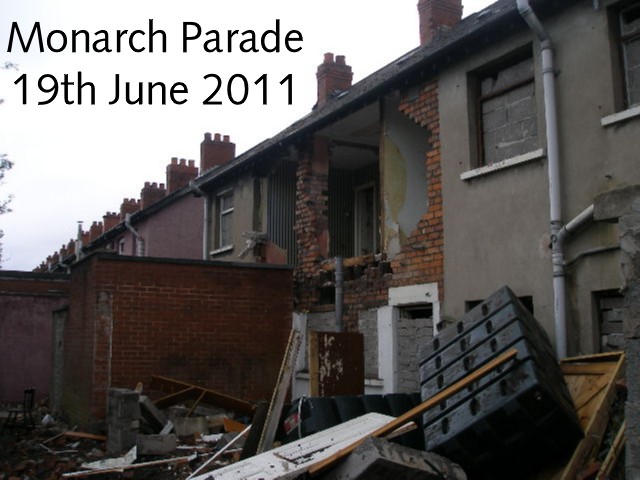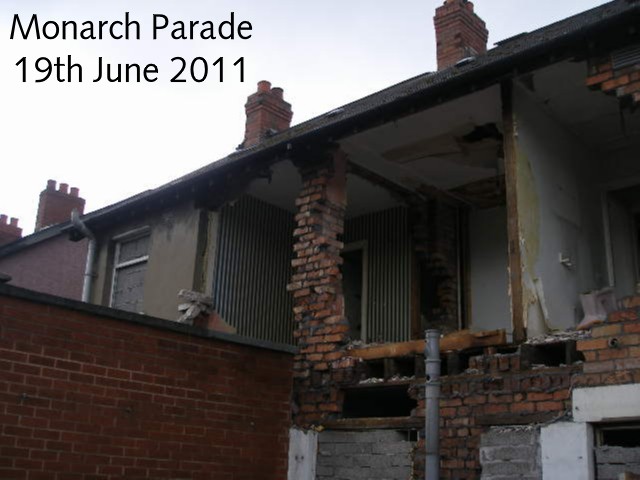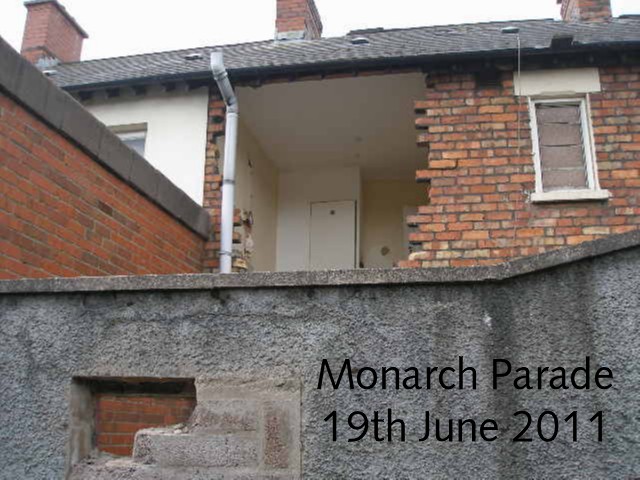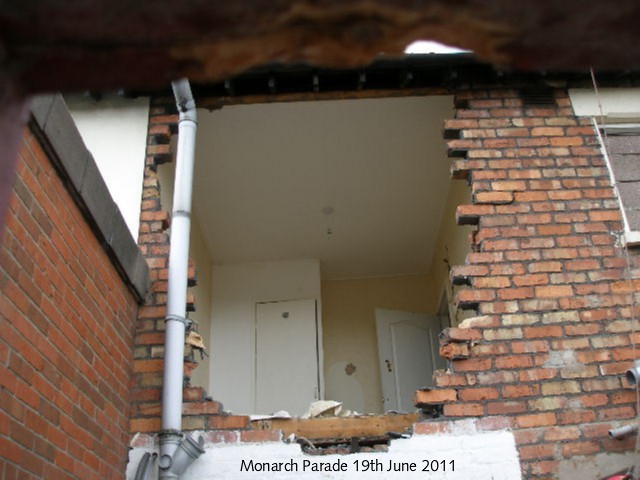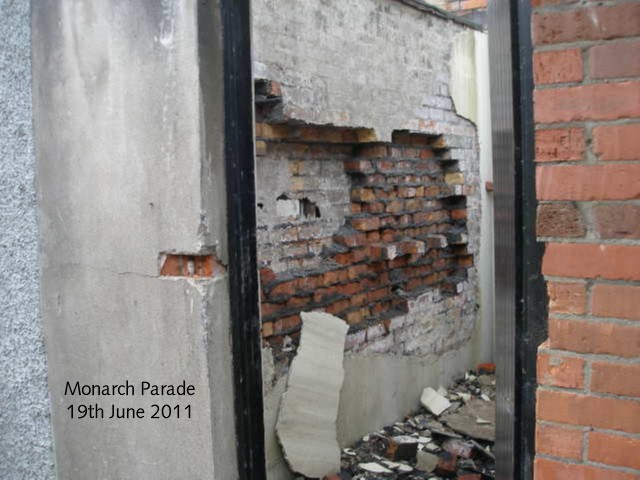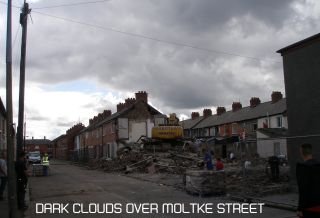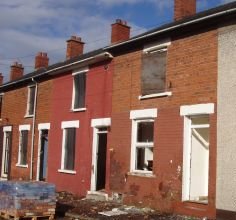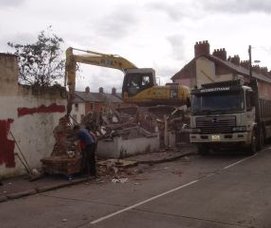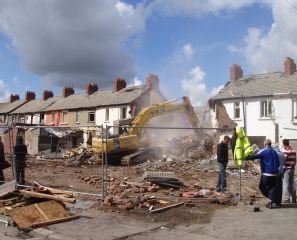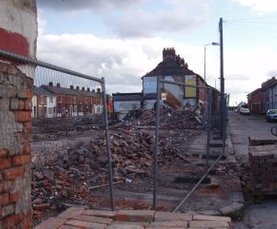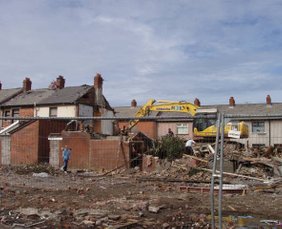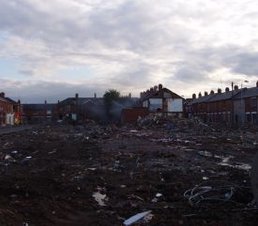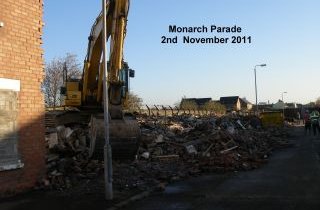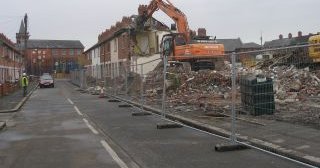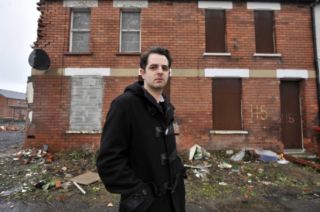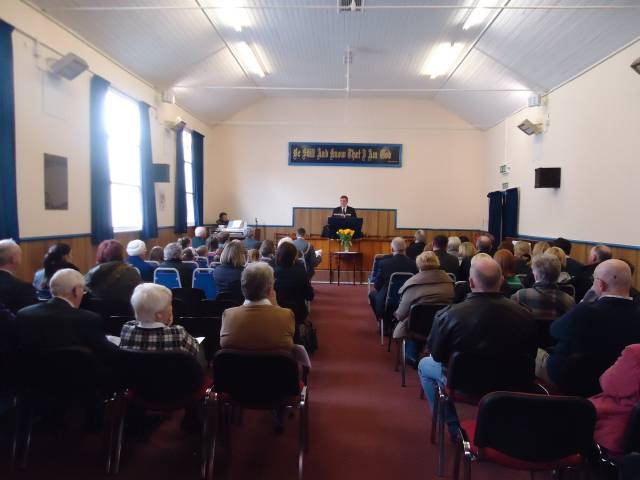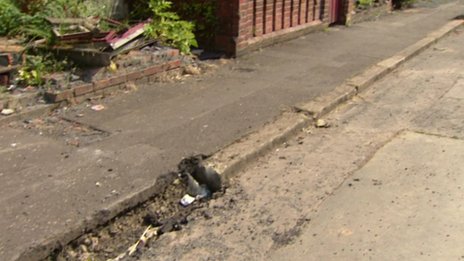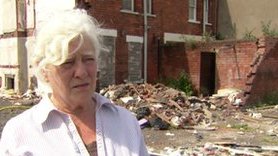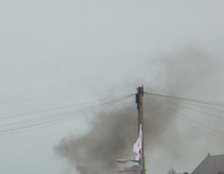BLACKSTAFF COMMUNITY DEVELOPMENT ASSOCIATION
(BLACKSTAFF RESIDENTS)
BIG EVENT!
BBC NEWS REPORT 9 JUNE 2011.
Demolition of houses in the Village area (-actually it's the Monarch area-) gets under way
Demolition work has begun in the Village area of south Belfast as part of a scheme to regenerate the area.
Forty homes in Lower Rockview Street were knocked down on Thursday to allow for 36 new homes to be built later this year.
( Approximately 112 houses in the Monarch area will be demolished and replaced by 45 new houses )
The Village area is one of the most deprived in the city, many houses have no inside toilets. (In a written answer to Jimmy Spratt MLA on 25th February 2010 in the Northern Ireland Assembly, who asked the Minister for Social Development Margaret Ritchie how many houses in the redevelopment area of the Village, south Belfast, currently have outside toilets. Her answer was that the Housing Executive is not aware of any occupied properties in the redevelopment area of the Village which have outside toilets. More details on Page Two )
The Department of Social Development has earmarked 600 homes for demolition.
DSD Minister Nelson McCausland watched the demolition work begin.
"Through its very name the Village has been an important community area in Belfast for many years," he said.
"Unfortunately, the worsening housing conditions over those years led to the declaration of the Village as a redevelopment area.
(See Page One -"WHERE ARE THE 580 UNFIT HOUSES?")
"We are now seeing the start of the regeneration of this proud area through demolition of unfit housing (See Page One -"WHERE ARE THE 580 UNFIT HOUSES?") to make way for new homes built to very high standards." PLEASE NOTE: " to make way for new homes"
Our homes were taken off us to make way for new homes. We can't turn back the clock but we have the expect what was promised.
Mr McCausland said he was confident the Village would become attractive again in the coming years and that people would want to live and bring up their families in the area.
"To achieve this, it is vital that local people are involved in helping design the housing solutions to meet the needs of the people of the area," he said.
"Gaining commitment from local people is key to building successful communities."
The minister concluded: "The first phase involving the construction of 36 new homes will get underway later this year and will be an important milestone in the journey towards a new Village."
Housing Executive chairman Brian Rowntree welcomed the demolitions: "This is a good day for residents (MOST HAVE GONE AND WILL NOT BE BACK) and will allow the regeneration of the Village to begin in earnest.
"Our proposals will not only address poor housing conditions in the area but will provide a balanced approach to the retention and improvement of existing housing
( A misleading statement - see Home Page "Arbitrary Line") as well as the provision of new build housing."
BEFORE & AFTER
Copy of email sent to NIHE:
'Tonight (Saturday 11th June 2011) Lower Rockview Street looks like a street in 1941 after the blitz. On Thursday 9th June, as you know one side of the street was demolished. Today the fronts of most of the houses on the other side seem to have been unofficially demolished and they are in a dangerous state. My concern is that individuals may start demolishing where people live in the next streets. There is also a serious risk of people being injured or killed.' My concern became a reality on Sunday when bricks were removed from the end house at Monarch Street. Let's hope it does not get worse.
Liam Kinney (District Manager NIHE) informed the Community Design Team on Monday 13th June 2011, that he had a meeting with 'community representatives' and informed them that the destruction must stop. Let's hope so!
The Village and Monarch Community Design Team met on Monday, June 13 to discuss draft plans for phase 1 and 2 of the Village and Monarch Redevelopment. Phase 1 will include the even numbered side of Ebor Street and the odd numbered side of Broadway Parade bordered by Broadway and Frenchpark Street with Moltke Street being in the centre. Approximately 113 will be demolished and replaced by 36 houses. All the houses in the Monarch area will be demolished; approximately 112 and replaced by 45 houses There will be a mix of 4, 3, 2 bed houses and 2 bed apartments. Members of the Design Team are to consider the draft plans and make any suggestions for possible changes.
Northern Ireland
Brick bandits strip NIHE site in south Belfast
By Kevin MageeBBC News
Houses are being stripped despite the fact that people are living in adjacent homes.
The NI Housing Executive has appealed to people to stop dismantling houses to steal bricks which are being sold on as salvage. The appeal came as it emerged that so-called "brick bandits" are stripping a Housing Executive demolition site in the Village area of south Belfast.
A lucrative trade has grown up around reclaimed Belfast bricks which can retail for between 50p to £1 each.
The Housing Executive has warned people's lives are being put at risk.
Last week, demolition work started in the Village area as part of a scheme to regenerate the area.
The Department of Social Development has earmarked 600 homes for demolition.
Belfast bricks sell for between 50p to £1 each
However the site has already attracted gangs of people who are sifting through piles of rubble to claim the bricks.
The bricks are then being sold on to dealers for around £100 a pallet.
The Housing Executive said those involved have also targeted houses which are not yet due for demolition - regardless of whether of whether adjacent homes are still being lived in. The houses are being left in a dangerous condition.
The Housing Executive has called for a stop to the "wanton vandalism".
The people who are responsible for the above demolition do not care for those who live in the area. What will the NIHE and PSNI do to protect the people still living in the Monarch area?
The demolition of the first houses in Phase 1 at Moltke Street. Although we still have a few concerns, we do not have the same situation that developed in the Monarch area. We sincerely hope it will continue.
The above is what we said on 4th August. On the 22nd August we made the following statement:
"Even though the NI Housing Executive appealed in June for people to stop removing bricks from houses which are not yet due for demolition; that appeal has fallen on deaf ears. The brick bandits have been hard at work taking bricks from houses in Frenchpark Street, Moltke Street and Broadway Parade. Houses that had been secured to prevent vandalism have had been broken into by individuals and now are in a dangerous state. A glimpse inside these houses will reveal the damage that has been caused by those who entered them. The sound of running water can be clearly heard from at least two houses. A few residents had to move out for their own safety and we appreciate the help of the NIHE and Anna Lo MLA in helping to rehouse them. We understand the PSNI have been seen in the area EVERY DAY and have taken action to try and deal with the situation. However the nightmare continues and the local community don't believe that things will get any better. The NIHE and the PSNI must now focus on stopping the situation spreading to the area bordered by Broadway, Kitchener Street, Kitchener Drive and Moltke Street."
THE END OF RUBY MURRAY'S HOUSE AT
84 MOLTKE STREET.
WHAT IT WAS LIKE TO LIVE IN THE VILLAGE REDEVELOPMENT AREA
PHOTO: EBOR STREET SEPTEMBER 2012
I lived on Ebor Street, where most of the houses were already blocked up on our side. One by one people moved out and their houses blocked up. From June 2011 to December 2011 (when we were finally removed) we were tortured and our lives put at risk.
Children, aged between 10 and 15 were running up and down the alley walls, removing lead and copper from the roofs. They left a gaping hole in our roof, putting us at risk of flooding. They also stole our front gate while we were out. Soon after, we came home one night and found our front wall knocked down. The next morning a man arrived with a van and tried to lift the iron from the wall into the back. I caught him, so he dropped it and drove off. Luckily the housing executive cleared it away before he came back, I did not want him to profit from our misery. I wanted to report him, I took his description and licence plate number, but my husband warned me not to in case he tried to get me back.
Not long after, around the end of September, I woke about 5 in the morning to the sound of scratching behind our bedroom wall. I woke up fully, realizing that it was a fire set in the blocked up house, under the staircase adjacent to the party wall. We evacuated the house, my husband, myself, our three cats and our unborn child. This was the last straw. They were repeatedly breaking into that house and we had reported it to NIHE numerous times. The steel they had used to block the front door had been broken away for months. We could hear them in the roof space salvaging the copper and boiler. So many times we told the NIHE we did not feel safe with them, fearing they would break in to our house for our copper pipes. It took the vandals to light a fire, for a fire to be lit under them to get us moved. Even so, it took months for them to move us. One day I went to leave for town and a contractor from NIHE was outside our house. 'Do you live here?' He asked. 'Yes,' I said. 'Oh! We were about to block this house up!' he replied. Disgusting.
We also had trouble with NIHE in November 2010. Our heating was broken (during the worst winter of the century) and we tried and tried to get them to come fix it. This was before the burst pipe saga affected the whole country. Eventually we resorted to knocking the wall in to the old chimney shaft and make a fireplace to keep warm. Around March, we got a knock on the door about midnight. It was the emergency repairman. He promptly left, as he was the gas repairman and we had oil. But, because they took so long to repair our heating system our heating pipes burst in our kitchen, collapsing the ceiling. We were still without heating.
But, what do they care if we froze or burnt to death?
WE HAVE NOT PRINTED THIS PERSON'S NAME OR HOUSE NUMBER
Belfast News Letter: Published on Wednesday 16 January 2013 13:24
A MAN forced to bear the full costs of a mortgage on a demolished house has spoken out after a landmark ruling against him.
Joel Kerr, 31, had purchased a two-up, two-down terraced house in south Belfast in February 2007 for the price of £152,500.
But he was unaware that it would soon be demolished to make way for a massive regeneration of the neighbourhood, and had fought a legal battle against the Housing Executive after it forced him to sell.
Because the housing crash took place in the intervening years, the value of the property dipped sharply – and the Housing Executive made an offer of just £91,000.
He lost his case last week, and has now spoken about the quandary he finds himself in.
Mr Kerr, who works for an educational IT firm and now rents a dwelling in Holywood, still pays £600 per month to his bank for the house in Moltke Street in the Village area of the city, despite the fact almost the entire street is no longer there.
He said: “I had shopped around quite a bit, and found it was the best property within the price range I had in mind.
“It had a double extension out the back. It had been completely renovated before I moved in. It was in perfect shape – it was a solid house.
“Apparently there were houses in the area not in great shape. I don’t dispute that. But mine was fine.”
He said he had not known anything about the regeneration until he was notified of the Housing Executive’s vesting order – the intention to compulsorily purchase the property.
“I wasn’t really sure what it meant,” he said.
“I probably didn’t act that quickly. Something like that is huge, and I probably carried on as normal, and thought I would deal with it at some stage. It took a while to sink in.”
It was suggested some people may be surprised by that, but he said: “Whenever you’re buying a house, I don’t think you really expect it’s going to get knocked down the next year.”
The home was vested in April 2010. He never accepted the offer of £91,000 from the government, but said the judgment of the court now leaves him facing few options.
“I’m paying a full mortgage on a house that’s knocked down,” he said.
“It’s difficult to understand how in this country you can be left in a situation like that.
“There’s no real solution for me. There’s no solution. That’s the end of it. That’s the situation I’m left in.
“I think the message that came from the ruling is: ‘Some people win, some lose. You lost. Tough luck’.”
Although he had shared with a tenant when he first moved in, he said his intention was for him to live there, and the house was not a mere investment.
According to Joe Allen, a chartered surveyor who was advising Mr Kerr, the demolition-and-regeneration scheme had “been on the cards” for about 10 years.
But he said that until the vesting orders are actually confirmed it was “in limbo”.
He also said “nobody could foresee the downturn in the market at the stage”.
“He’s having to pay a mortgage on a house that no longer exists, and pay rent on alternative premises,” he said. “The judge said there’s nothing that can be done about – it’s tough.”
His mortgage was for the full 100 per cent of the £152,000 of the home’s old value, he added.
The Housing Executive, which is responsible for the redevelopment, said it could only pay market rates for the homes bought on a compulsory basis – and this is what Mr Kerr was challenging.
The case came to a head last week when a judge ruled that Mr Kerr is not entitled to get any more than the market rate for the home after all.
Attorney-General John Larkin, representing Mr Kerr, had argued that the full value of the house should be paid, not just the value at the time it was vested.
But Lord Justice Sir Patrick Coghlin disagreed, although he did award Mr Kerr his legal costs and said it may be appropriate for the department to review its policy in regard to such cases.
He said that the law tries to balance the need for regeneration with the needs of those who are adversely affected by it – but it does not try to “resolve every anomaly and hardship”.
Mr Kerr’s battle was seen as a test case for an estimated 25 others in a similar position who feel they lost out on the development.
All in all, the three phase development covers homes in the Village area to the east of the Broadway roundabout, as well as the adjacent area known as Monarch.
Generally speaking, this refers to the area which stands just to the north of the Donegall Road.
The Housing Executive said by the time it is finished 538 homes will have been demolished and replaced by 270. Out of these, 134 will be social housing.
The Department for Social Development, responsible for housing, said: “The minister (Nelson McCausland) has already commented that he has great empathy with the many people in Northern Ireland who currently find themselves in negative equity, and has instructed officials to re-examine the policy to support owner-occupiers in redevelopment areas to determine if this can be amended to take account of the issue of negative equity.
“However, this will require some detailed legal analysis and consultation with his ministerial colleagues.”
In the wake of the court decision last Thursday, Mr McCausland issued a statement which read: “While I empathise with the many people in Northern Ireland who currently find themselves in negative equity, I welcome the clarity this judgment brings to the issue of compensation when property is vested in areas which require significant regeneration to provide residents with modern, comfortable homes that are fit for the future.”
Email fro Kathleen, former resident and homeowner: "You say the Long Streets in North Belfast were surveyed correctly unlike the Village and Monarch areas. Margaret Ritchie was on a mission to get more social housing built at the time. She was not interested in the state of the houses or what affect it would have on the residents and that is why it was not surveyed properly. I also doubt if many of the former home/owners will return. With the new "bedroom tax" elderly people would only be entitled to a one bedroom flat and have less space than they had in their old houses. Also, alot of alcoholics are given "single ends" by the housing executive. The only people who will benefit from moving back will be families with young children who will be entitled to 3 bedroom homes. What saddens me is that honest hardworking people have been moved out of their homes to make way for people who enjoy living on benefits. At this moment in time there is anti social behaviour on these estates expecially round Antrim.
A Dedication Service was held in Kilburn Street City Mission Hall on Monday, April 8 to commemorate the completionof the first 10 homes in the Village & Monarch Redevelopment Area. The dedication was preformed by Rev. William Hoey, former rector of St. Simon’s Parish Church. Other clergy from the local churches took part and the congregation thoroughlyenjoyed the wonderful singing by Fane Street Primary School Choir The Lord Mayor of Belfast, Alderman Gavin Robinson and DSD Minister, Nelson McCausland both spoke of their delight, that after years of waiting, the community were now seeing the results of all the hard work. Anita Conway, Fold Director of Development also commented on the hard work that went into the project and thanked especially the Village & Monarch Community Design Team The DSD Minister and the Lord Mayor had the opportunity after the service to visit a family in one of the new homes. The ladies of Kilburn Street Mission Hall rounded off a most wonderful service by providing refreshments for all who attended
.
BBC NEWS 4 July 2013 Last updated at 17:26
Village life inside south Belfast's urban demolition zone
Many granite kerbstones in nearby streets are thought to have been stolen Louisa Blackburn is living in the middle of a demolition site.
Most of the houses in her street have been razed to the ground, but her home is propped on either side by an abandoned, bricked-up, building.
The pensioner is among a handful of people still living in what little remains of this part of Soudan Street, in an area of south Belfast known locally as the Village.
The Village is undergoing a multi-million pound regeneration scheme, and hundreds of substandard homes have already been pulled down to make way for new, modern housing.
However, the area has long been the target of vandals, fly-tippers, metal thieves and so-called brick bandits, who it appears, are continuing to strip the demolition zone of anything they can sell.
Fires
As Louisa and her few remaining neighbours wait to be re-housed, rubble and rubbish is piled up outside their homes. Fires are being set in waste ground, just feet from occupied houses.
Even the granite kerb stones are disappearing from underneath their feet.
Louisa Blackburn fears fumes from fires set near her home could be detrimental to the health of residents
Several months ago, metal thieves ripped lead flashing from Louisa's roof, leaving her to deal with rainwater leaking into her kitchen.
Now, she believes copper is their new target. The pensioner said she has witnessed men setting fire to electrical cables right outside her home.
"Basically copper is a very valuable metal at the moment. You can get a good price for selling it and that's the reason they're burning the cable, to get the copper out," she said.
"It's not just from the demolished houses. I have seen different vans coming in with wheeled bins full of this cable, and just making a bonfire. We have to suffer the consequences of other people coming into the area and doing that."
The former staff nurse is concerned about toxic fumes and has complained twice to Belfast City Council's Environmental Health department.
'Dumping'
A spokesman from the department said the practice of burning cables on waste ground is illegal and they do get a handful of similar complaints each year.
Billy Dickson photographed the thick black smoke created by nuisance fires
But unless the authorities actually catch someone in the act, it is very difficult to bring prosecutions, he added.
Billy Dickson is a long time Village resident and a member of the local community design team, set up by the authorities to play an active role in the regeneration scheme.
He shares Louisa's concerns about vandalism, fires and pollution.
About three weeks ago, he photographed a large plume of black smoke rising up from the waste ground near Louisa's home and said the burning of cables and other anti-social behaviour is a continuing problem in the Village.
"Maybe 50%, 60% of the area is not going to be built on, and there is no commitment to build. That means you have wide open space that will be used for dumping and all sorts of problems and we want to get the message out - we want all this to stop."
'Wanton vandalism'
The Northern Ireland Housing Executive (NIHE) is responsible for the demolition and redevelopment site.
Two years ago, it warned that so-called brick bandits were putting lives at risk in the Village, by stripping bricks from abandoned houses, regardless of whether anyone was still living in the houses living next door.
But despite the risks, the practice appears to have continued.
In this BBC News report, we have high highlighted a few of the comments by Nelson McCausland the new DSD minister and the NIHE chairman Brian Rowntree along with our own comments in brackets.
Village regeneration in numbers
Overall plan:
- 538 homes to be demolished
- 273 homes to be constructed
- 734 homes to be improved
'Progress' to date:
- 27 homes left to be demolished
- 139 new kitchens installed
- 139 'external improvements'
- 94 home fitted with new windows
When the BBC arrived in the Village last week, we witnessed a pallet of bricks being quickly loaded on a truck and taken away, just as we brought our camera out to film.
The Housing Executive has repeated its appeal to those responsible for "wanton vandalism" to stop immediately and urged residents to report brick theft.
A spokeswoman said NIHE staff visit the area "on a daily basis and have not received any recent reports about materials from empty properties being burned at this location".
But the remnants of at least five fires are visible on the waste ground close to Louisa's home, including one that was set against the abandoned house next door.
Challenges
Councillor Paula Bradshaw, director of the urban regeneration charity, the Greater Village Regeneration Trust, led a clean-up of the area last week.
She said there are always going to be challenges during a major project like this.
"We're doing the best we can and I'm content that the PSNI and the Housing Executive are doing a good job as well. It's not easy," she said. (Is this a sick joke?)
"So it's really a question of, let's get these houses up as soon as possible, so that we can't have these problem, so that the dangers are eliminated as soon as possible."
<a href="https://voicemap.me/users/william-billy-dickson-bem">Belfast self-guided audio tours</a>
The Village regeneration project is the biggest scheme of its type in Northern Ireland and under the plans, 538 houses were earmarked for demolition.
They are to be replaced by just under half that number (273) of new, better quality homes.
It is now two years into the project and the demolition and rebuild process is well underway.
Just 27 of the old houses still remain to be torn down, while 87 of the new properties are now either ready or nearing completion.
More than 700 houses located just outside the demolition zone are also due to benefit from the regeneration scheme, at a total cost of almost £1m.
Louisa and her neighbours are expecting to be re-housed within months.
But in the meantime, she said more should be done to protect the remaining residents from anti-social behaviour.
Hagan Homes are to build 70+ new homes in the Village. A friend of our association said they have been brilliant at building and selling affordable homes throughout the recession. We were hopeful that this would be the case but we have been left betterly disappointed. Hagan Homes refused to meet me to explain the high prices and why the difference between the new house prices on the Shankill and those at Lower Broadway (Village).
If you would like to comment on the contents of this website or apply to join the Blackstaff Community Development Association (Blackstaff Residents) then you can email feedback@blackstaff-residents.org.uk

